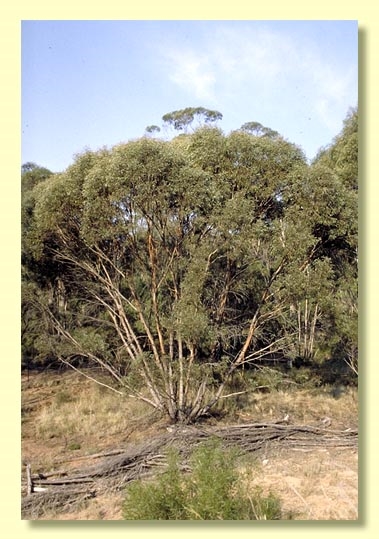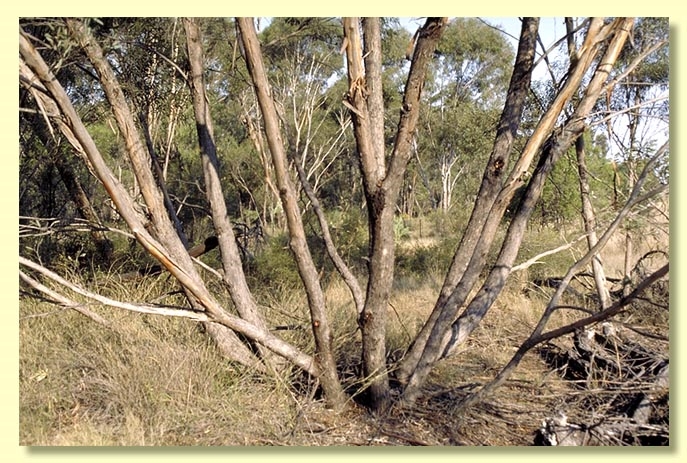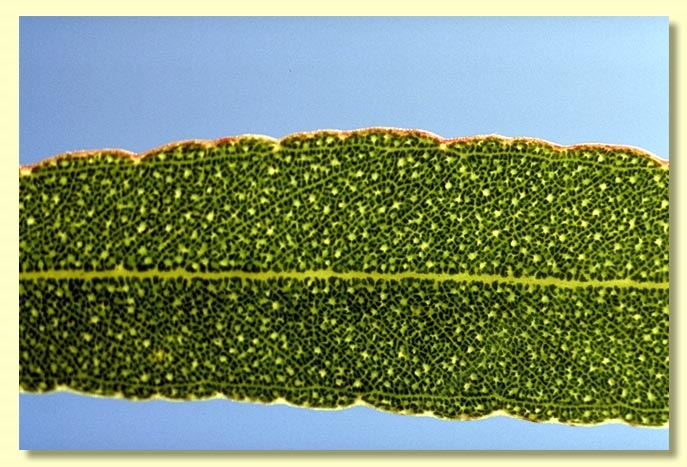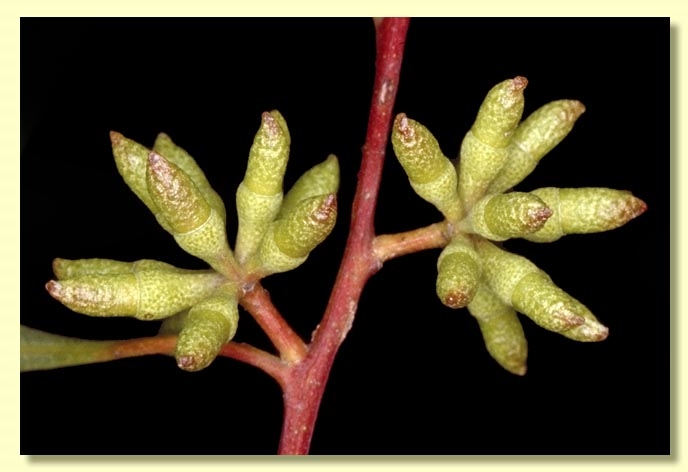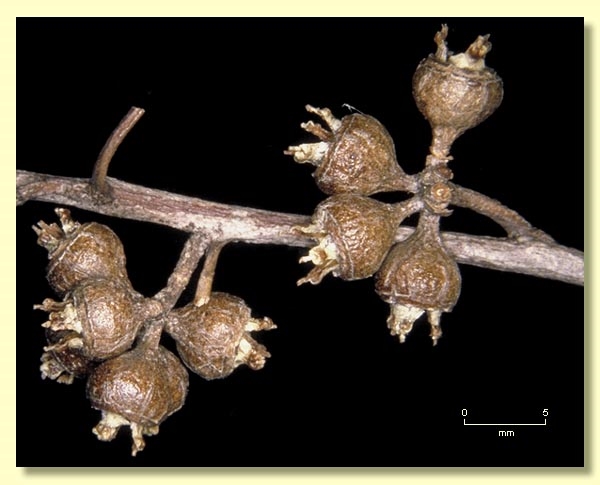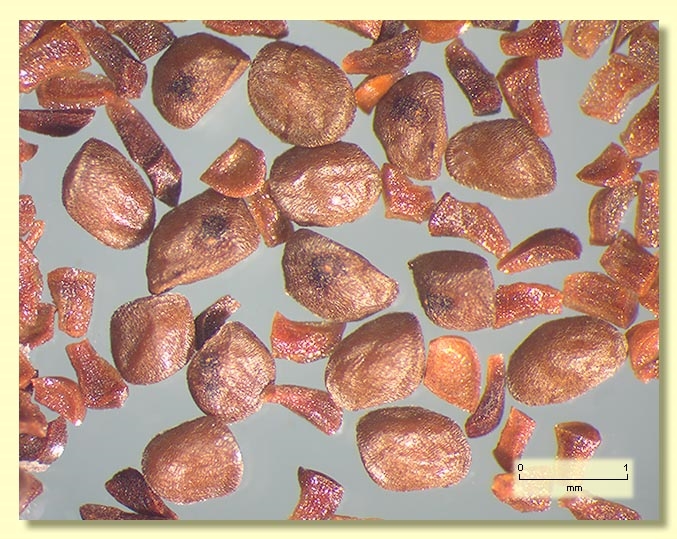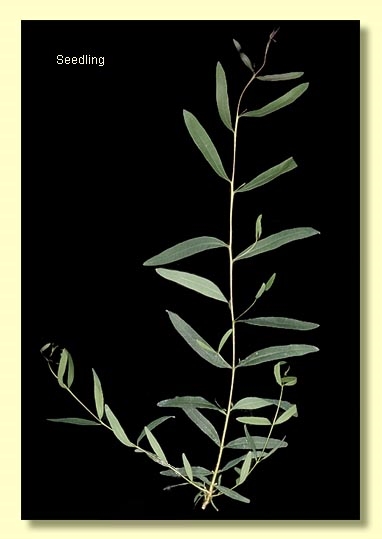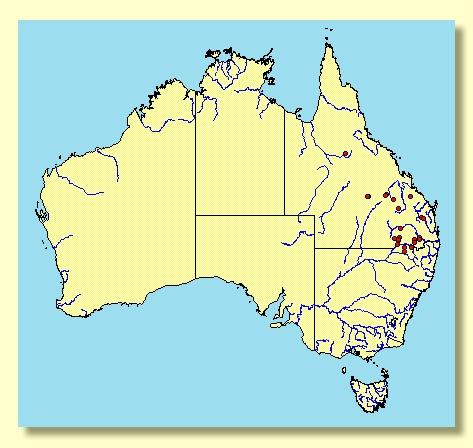Euclid - Online edition
Eucalyptus bakeri
Eucalyptus | Symphyomyrtus | Bisectae | Destitutae | Micrantherae | Bakerianae
T: Ticketty Well, NSW, July 1911, E.H.F.Swain s.n.; holo: NSW.
Trees have rough bark on part or all of trunk, box-like or compacted or slightly tessellated, grey, branches smooth. In mallees the bark is entirely smooth, sometimes slightly powdery, grey, green, brown, coppery, orange, yellow or cream, at times with ribbons of decorticated bark on the stems and branches.
Juvenile growth (coppice or field seedlings to 50 cm): stem rounded or square in cross-section, smooth or slightly warty; juvenile leaves opposite and sessile for 8–12 pairs, becoming sub-opposite then alternate, sub-sessile, linear or narrowly lanceolate, 5–8 cm long, 0.3–0.5 cm wide, base tapering, green or grey-green.
Adult leaves alternate, petiole 0.5–1.3 cm long; blade narrowly lanceolate to linear, 4–10.5 cm long, 0.5–1.5 cm wide, base tapering to petiole, concolorous, glossy or dull, green, side-veins greater than 45° to midrib, densely to very densely reticulate, intramarginal vein parallel to and just within margin, oil glands numerous, conspicuous, intersectional.
Inflorescence axillary unbranched, peduncles 0.3–1.5 cm long, buds 7 to ?15 per umbel, shortly pedicellate (0.1–0.2 cm long). Mature buds oblong to fusiform (0.8–1.1 cm long, 0.2–0.4 cm wide), scar present, operculum conical to horn-shaped, stamens irregularly flexed, anthers globoid to butterfly-shaped, versatile, dehiscing by pores, style long, arising between three prominent lobes on the ovary roof, stigma tapered, locules 3 or 4, the placentae each with 4 vertical ovule rows. Flowers white.
Fruit sessile to shortly pedicellate (pedicels 0–0.2 cm long), cup-shaped, hemispherical or truncate-globose, 0.3–0.4 cm long, 0.4–0.5 cm wide, disc slightly raised-annular or convex or disc level, valves 3 or 4, strongly exserted; the valves each have a small lobe (bump) on the back below the apex.
Seeds brown, 0.9–1.5 mm long, ovoid or flattened-ovoid, sometimes faintly furrowed, dorsal surface smooth or pitted, hilum ventral.
Cultivated seedlings (measured at ca node 10): cotyledons Y-shaped (bisected); stems square to rounded in cross-section, sometimes warty; leaves sessile, opposite for at least 7 to 12 nodes then becoming alternate, narrowly lanceolate, 5–10 cm long, 0.3–1.5 cm wide, base tapering, green.
Flowering has been recorded in June, July, August and December.
Mallee or small tree of the Yetman area in far northern New South Wales and south-eastern Queensland, particularly the Talwood, Dalby and Roma areas, with a northern outlier in the White Mountains near Pentland. It has rough basal bark and linear, slightly glossy, green juvenile leaves.
Eucalyptus bakeri belongs in Eucalyptus subgenus Symphyomyrtus section Bisectae subsection Destitutae because buds have two opercula, cotyledons are Y-shaped and branchlets lack oil glands in the pith. Within this subsection E. bakeri is closely related to E. mannensis (from central Australia), E. jutsonii (from north of Kalgoorlie in the Western Australian Goldfields) and E. micranthera (from the Esperance area on the Western Australian southern coast). Together they form subseries Micrantherae sharing the unusually three-lobed ovary roof, conspicuous intersectional oil glands in the leaves, mallee habit and thick-rimmed fruit.
E. bakeri may be confused with the unrelated E. viridis, with which it may occur, but differs by the densely reticulate adult leaves with intersectional oil glands, and the lobed ovary roof. In addition E. viridis has fruit with a descending disc and enclosed valves.

